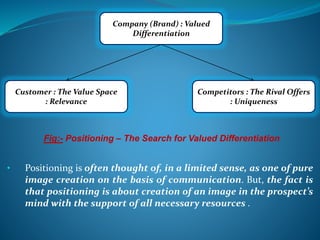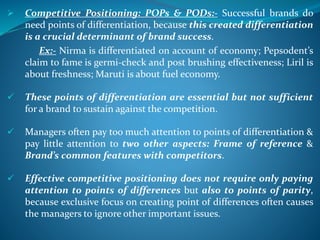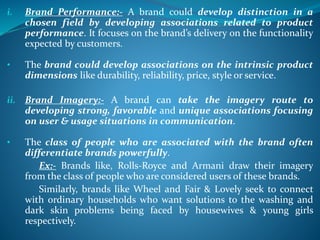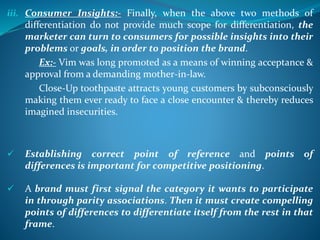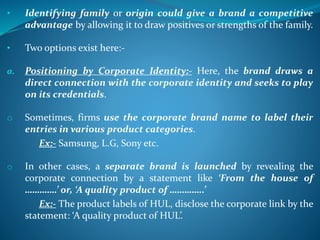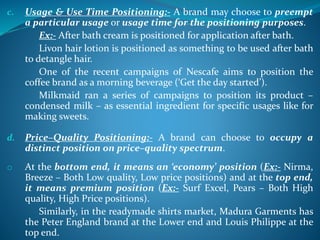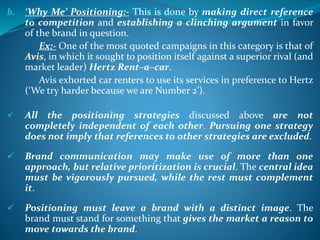Brand positioning
- 1. Brand Positioning:- Today, the environment is filled with too much of communication, and in an over communicated society, the mantras that ensured success in the past, when communication was limited, are no longer effective. Ries & Trout suggested that success in an over-communicated society like the present one; creativity by itself cannot guarantee success. In order to succeed, the marketer must create a position in the prospect’s mind. The position must take into consideration a company’s strengths & weaknesses along with that of competitors. Positioning is governed by the rule of first mover advantage. The brand must perceptually get into a prospect’s mind first. Ex:- It was the Sperry Rand company that first invented the computer, which very few people know. Most associate IBM with computers, as IBM got into perceptual space & occupied the computer position first.
- 2. Positioning is about building the image of a brand. It is ‘the act of designing the company’s offerings: an image to occupy a distinct place in the mind of the target market’. Most successful brands occupy distinct position that sets them apart from the competition & provides the target customer a reason to favour them. Ex:- Liril – Freshness; Dominos – Guaranteed pizza delivery in 30 minuts; Fair & Lovely – Fairness cream; Bata – Value for money shoes; Woodland – Sturdy shoes for adventure sports; Zodiac – Fine quality shirts. Etc. Brand position signifies the Subjective or Perceived attributes in relation to other competing brands. Positioning is all about shaping an image about a brand in prospect’s mind. Many brands are perceived as topmost performers, although in an objective sense they may not have the best product. The image of Quality or Superiority is a crucial determinant of a brand’s success.
- 3. 3 Cs of Positioning:- For a brand to take part in the consumer decision process, it must clearly signal what it is all about i.e., a brand must appropriate a distinct idea. In this process of finding a concept that simultaneously bestows the brand with value & differentiation, an analysis of three sides to a marketing exchange is essential:- i. Target Customer (Relevance):- The first and the foremost consideration in search for a position is the concept of target market or customer. • Customers are relevant for two reasons: First, they are the targets for the positioning effort. Second, they are the ultimate marketing targets. • The positioning is done to elicit a positive purchase response from the target customers. • The target customers or segment needs to be defined in terms of both the demographic & psychological variables.
- 4. • Clear definition of the target market helps in efficient deployment of marketing efforts in cultivation of an image. Ex:- Indigo CS, was targeted at the young, urban economy sensitive customers. • Marketing is not about actual winning of the customers, rather, what is at stake in marketing battles, is their purchase vote. The potential buyer must voluntarily respond favorably to the brand in question. • Ries & Trout suggest that ‘to find a unique position, you must ignore conventional logic’. According to conventional logic one turns to oneself or the product to find an unique positioning concept. For Positioning, one must turn to the prospect’s mind, because, Potential positioning concepts reside in the prospect’s mind, not in the product or in the creative imagination of the marketer. • How a product category is conceptualized by the customers, serves an important starting point in brand positioning.
- 5. ii. Target Competition (Uniqueness):- If a brand enters in a pristine value space where it meets no competition, it is the best strategy. In a way, positioning is also about choosing one’s competition. • Once the value space is identified, two types of competitors could be distinguished:- a. The direct competitors:- This is intra–product category competition between various brands of the same product. Ex:- Bata vs. Liberty in the shoe market; Add vs. Cello in the gel pens market. b. The Second level of competition takes place between two product categories competing to serve the same customer needs. Ex:- Coke vs. Lassi or Sharbats. • The importance of factoring competition in the positioning process is to discover the Occupied and Unoccupied brand positions.
- 6. • When a brand has already occupied a position in the prospect’s mind it enjoys first mover perceptual advantage. Ex:- IBM – Computers; Lux – Beauty soap segment. This is most important because it is near impossible to dethrone a brand from its perceptual position. • Shifting perceptual position requires unlearning the current image and re–learning something new about a brand. Unlearning is one of the most difficult psychological processes. • It is for this reason that the search for position must avoid confrontation with an Existing brand; instead, a new unoccupied position must be discovered. • The study of the positions occupied by competitors is essential for discovering something that is unique in the current frame of competition. Ex:- When Star Gold was launched it was positioned as the channel that shows movies of ‘Golden’ years of Hindi Cinema (a Hypothetical concept to attract older crowds, who feels nostalgic about past) against other channels devoted to all kinds of movies without any specification.
- 7. iii. Company Or Brands (Value Proposition):- Brands represent values that a marketer packs for its customers. • Focus on the customer value space creates customer focus & helps develop market relevant offerings, but, this may lead to brands becoming undistinguished in the competitive space as other competitors may offer similar value. • Similarly, if concentration is limited to competitors, it would certainly lead to unique or different propositions. But, differentiation so achieved may not be valued, because uniqueness so achieved may come at the cost of relevance. • Combining the above two dimensions representing relevance (customer side) and uniqueness (competitor side) enables the marketer to choose a path to create an image for the brand that is both relevant and unique. • Relevant resources & competencies must back whatever is the position that a marketer intended to create for his brand.
- 8. • Positioning is often thought of, in a limited sense, as one of pure image creation on the basis of communication. But, the fact is that positioning is about creation of an image in the prospect’s mind with the support of all necessary resources . Company (Brand) : Valued Differentiation Competitors : The Rival Offers : Uniqueness Customer : The Value Space : Relevance Fig:- Positioning – The Search for Valued Differentiation
- 9. Competitive Positioning: POPs & PODs:- Successful brands do need points of differentiation, because this created differentiation is a crucial determinant of brand success. Ex:- Nirma is differentiated on account of economy; Pepsodent’s claim to fame is germi-check and post brushing effectiveness; Liril is about freshness; Maruti is about fuel economy. These points of differentiation are essential but not sufficient for a brand to sustain against the competition. Managers often pay too much attention to points of differentiation & pay little attention to two other aspects: Frame of reference & Brand’s common features with competitors. Effective competitive positioning does not require only paying attention to points of differences but also to points of parity, because exclusive focus on creating point of differences often causes the managers to ignore other important issues.
- 10. Ex:- For instance, a fast food brand tries to differentiate itself from the other players in the fast food category on the key proposition of health. But, a brand so promoted on the health platform may change the point of reference as far as customer’s judgment about a brand is concerned. Customers may see health & taste as two different categories. Thus, differentiation so pushed on the health basis may pull the brand out of the fast food category and place it in the health food category. Hence Point of Differentiation should be deeply contemplated upon before being pursued. A. Frame of Reference:- Frame of Reference is the starting point for competitive positioning. What the customers should expect the brand to deliver or perform is visualized & created by establishing a frame of reference.
- 11. Two types of frame of references could be distinguished:- i. When the frame of reference for a brand is other brands in the same category. Ex:- Mirinda’s frame of reference is Fanta, as both being orange soft drinds. Creta’s frame of reference is S-Cross. • In these cases the brand is benchmarked against other brands in a given product category. ii. Many times, a brand may seek to establish a point of reference in a different product category. i.e., the brand jumps the product category by making customers think about the brand in a different category context. Ex:- Chocolate-coated wafers like Cadbury’s Perk jumped the category to develop frame of reference with ready to eat snacks. Rolex has its point of reference not in the category of wristwatches but prestige.
- 12. For a brand to be taken as a serious participant in a particular context, it must establish convincing points of parity. Each category is uniquely characterized in the customer’s mind. To seek entry, the brand must develop points of parity with that category. Ex:- Bathing soaps are predefined in the customer’s mind. If a brand wants to take part in this category, it must develop its share of parity (commonality) with the category or else it would fail to be thought of as a bathing solution. B. Points of Difference:- Once the point of reference is correctly established, the next positioning challenge is to create compelling points of differences. Developing strong, favorable & unique associations is fundamental to creating effective brand differentiation. Three ways of building differentiation could be identified: Brand Performance, Brand Imagery, and Consumer Insights. Depending upon the rout chosen, the brand associations could be developed accordingly.
- 13. i. Brand Performance:- A brand could develop distinction in a chosen field by developing associations related to product performance. It focuses on the brand’s delivery on the functionality expected by customers. • The brand could develop associations on the intrinsic product dimensions like durability, reliability, price, style or service. ii. Brand Imagery:- A brand can take the imagery route to developing strong, favorable and unique associations focusing on user & usage situations in communication. • The class of people who are associated with the brand often differentiate brands powerfully. Ex:- Brands like, Rolls-Royce and Armani draw their imagery from the class of people who are considered users of these brands. Similarly, brands like Wheel and Fair & Lovely seek to connect with ordinary households who want solutions to the washing and dark skin problems being faced by housewives & young girls respectively.
- 14. iii. Consumer Insights:- Finally, when the above two methods of differentiation do not provide much scope for differentiation, the marketer can turn to consumers for possible insights into their problems or goals, in order to position the brand. Ex:- Vim was long promoted as a means of winning acceptance & approval from a demanding mother-in-law. Close-Up toothpaste attracts young customers by subconsciously making them ever ready to face a close encounter & thereby reduces imagined insecurities. Establishing correct point of reference and points of differences is important for competitive positioning. A brand must first signal the category it wants to participate in through parity associations. Then it must create compelling points of differences to differentiate itself from the rest in that frame.
- 15. Positioning Strategy:- Positioning strategy is aimed at building brand differentiation within the value frame of the target market. This need is primarily triggered by emergence of intense competition in most of the product categories, as the competition implies imminent product similarity & loss of identity. Positioning is increasingly seen as a device to gain control over markets by means of customer pulling Brand Differentiations. Positioning strategies revolve around different aspects of the brand. The four questions that can reveal the totality of a brand are: Who am I? What am I? Why am I? and Why me? i. Who am I :- In the context of branding, answer to this question would reveal the origin or pedigree of the brand: Where it belongs, or where it comes from?
- 16. • Identifying family or origin could give a brand a competitive advantage by allowing it to draw positives or strengths of the family. • Two options exist here:- a. Positioning by Corporate Identity:- Here, the brand draws a direct connection with the corporate identity and seeks to play on its credentials. o Sometimes, firms use the corporate brand name to label their entries in various product categories. Ex:- Samsung, L.G, Sony etc. o In other cases, a separate brand is launched by revealing the corporate connection by a statement like ‘From the house of ………….’ or, ‘A quality product of …………..’ Ex:- The product labels of HUL, disclose the corporate link by the statement: ‘A quality product of HUL’.
- 17. b. Positioning by Brand Endorsement:- Unlike the previous strategy, here a successful brand is used as an endorser of a new entry. Ex:- Dabur uses its successful brand Vatika to promote products like shampoos. Nestle used the Maggi name to promote Ketchup, Pickles, & Soups. Raymond’s Park Avenue brand endorses Soaps, Belts, After Shaves, Perfumes & Deodorants, Ties, and Shaving Creams. ii. What am I :- In this category of strategies, a brand’s functional capabilities are used for positioning purposes. • Within this group, four options exist:- a. Category Positioning:- This involves making a product jump over the category it originally belongs to and positioning it in a different category. o This strategy is usually followed when the existing product category is overloaded and the brand is difficult to differentiate.
- 18. Ex:- Suryansh brand of diamonds are positioned as an investment, not as a piece of jewellery, promising higher rate of return than gold, real estate, art works etc. o For this strategy to work successfully the brand must offer tangible & compelling reasons to buy. b. Benefit Positioning:- This strategy involves choosing a unique, not–yet–offered benefit to position the brand. Ex:- Car buying motives include: Economy, Speed, Luxury, Esteem, and Safety. Depending upon how existing brands are positioned, a new brand could have an unoccupied benefit to position itself in the market. Similarly, Fructis Shampoo is positioned as ‘for strong’ hair. Clinic All Clear shampoo is positioned as an anti-dandruff shampoo offering the benefit of dandruff removal.
- 19. c. Usage & Use Time Positioning:- A brand may choose to preempt a particular usage or usage time for the positioning purposes. Ex:- After bath cream is positioned for application after bath. Livon hair lotion is positioned as something to be used after bath to detangle hair. One of the recent campaigns of Nescafe aims to position the coffee brand as a morning beverage (‘Get the day started’). Milkmaid ran a series of campaigns to position its product – condensed milk – as essential ingredient for specific usages like for making sweets. d. Price–Quality Positioning:- A brand can choose to occupy a distinct position on price–quality spectrum. o At the bottom end, it means an ‘economy’ position (Ex:- Nirma, Breeze – Both Low quality, Low price positions) and at the top end, it means premium position (Ex:- Surf Excel, Pears – Both High quality, High Price positions). Similarly, in the readymade shirts market, Madura Garments has the Peter England brand at the Lower end and Louis Philippe at the top end.
- 20. iii. For Whom am I :- Depending upon the segmentation scheme used to divide the market, a brand can focus on a specific customer group for positioning purposes. This limits the brand’s appeal to other groups, but greater relevance is achieved for the target group. The market can be divided in the following types of groups:- a. Demographic Groups:- Demographic variables like age, income, sex, education or location could be used to divide the market. Ex:- Medicare was positioned as a remedy for the young school going girls market. Zandu Kesri Jeevan is positioned as a strength tonic for old people. b. Behavioral:- The usage volume differs in the market and this gives rise to groupings like light, heavy and medium user segments. Ex:- Local Vanaspati focus on road side hotels and dhabas known for bulk consumption, where as good brands will focus on high end restaurants and hotels.
- 21. c. Psychographic:- A brand can also be positioned according to the psychographic traits of the people. Ex:- Pepsi has all along been positioned as drink of what they call a ‘new generation’ or ‘Generation Next’. Asian Paints is positioned as the brand for a group of self– expressive people. iv. Why Me :- Here the brand is positioned on the basis of a unique reason or clincher. Finding out a unique reason or argument to offer to prospects is key in this category of positioning strategy. a. Unique Attribute:- A brand must have a unique benefit or attribute to give the prospects a reason to buy. Ex:- Medimix Ayurvedic soap is positioned as made of 24 different herbal ingredients. Anchor White toothpaste boasts of being a 100% ‘vegetarian’ toothpaste. Johnson & Johnson ‘No tears shampoo’ is positioned as a non- hurting shampoo.
- 22. b. ‘Why Me’ Positioning:- This is done by making direct reference to competition and establishing a clinching argument in favor of the brand in question. Ex:- One of the most quoted campaigns in this category is that of Avis, in which it sought to position itself against a superior rival (and market leader) Hertz Rent–a–car. Avis exhorted car renters to use its services in preference to Hertz (‘We try harder because we are Number 2’). All the positioning strategies discussed above are not completely independent of each other. Pursuing one strategy does not imply that references to other strategies are excluded. Brand communication may make use of more than one approach, but relative prioritization is crucial. The central idea must be vigorously pursued, while the rest must complement it. Positioning must leave a brand with a distinct image. The brand must stand for something that gives the market a reason to move towards the brand.







